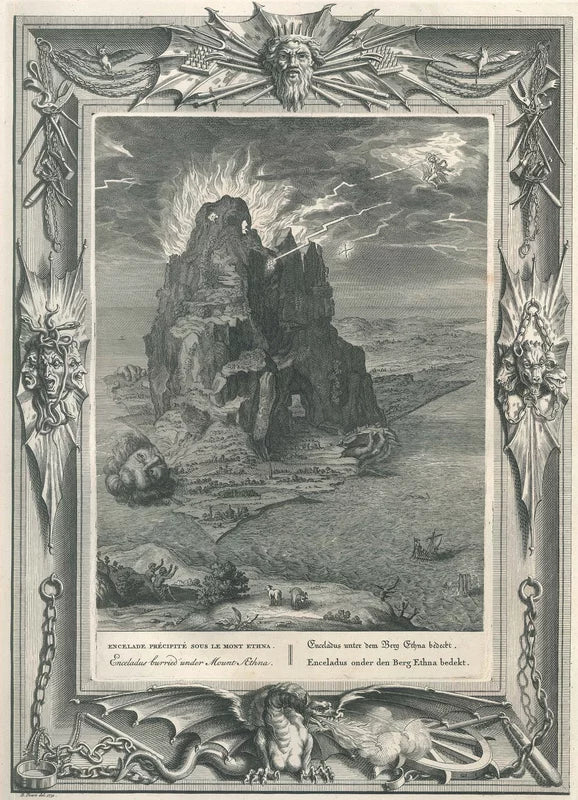ANTONIO RAIMO GALLERY
Picart, Mythology, Temple of Muses, Enceladus
Picart, Mythology, Temple of Muses, Enceladus
Couldn't load pickup availability
Bernard Picart’s *Cérémonies et coutumes religieuses de tous les peuples du monde* is renowned for its detailed depictions of classical mythology. The story of **Enceladus** is a dramatic example of mythological punishment and cosmic struggle, often illustrating the clash between the Titans and the Olympian gods. Here’s an overview of the myth of Enceladus and how Picart might have illustrated this story in the context of the **Temple of the Muses**:
### **Enceladus in Mythology**
- **Background:**
- **Enceladus:** Enceladus is one of the Gigantes, a race of giants who waged war against the Olympian gods in a conflict known as the Gigantomachy. According to myth, Enceladus was a formidable giant, often depicted as being directly involved in the battle against the gods.
- **Gigantomachy:** The Gigantomachy was a mythical battle between the giants and the Olympian gods. It represents the struggle between the old order (the Titans and their progeny) and the new order (the Olympian gods).
- **Punishment:**
- **Buried Under Mount Etna:** After the defeat of the giants, Enceladus was punished by being buried under Mount Etna in Sicily. The myth explains that the volcanic eruptions of Mount Etna are the result of Enceladus’s attempts to escape his subterranean imprisonment.
- **Symbolism:**
- **Divine Retribution:** Enceladus’s punishment symbolizes the power of the Olympian gods to subdue and control the chaotic forces of the primordial world.
- **Cosmic Struggle:** The story reflects the broader themes of cosmic struggle and the transition from chaos to order, as well as the eternal consequences faced by those who oppose divine authority.
### **Picart’s Depiction of Enceladus**
- **Artistic Representation:**
- **Temple of the Muses:** In Picart’s illustrations, Enceladus’s story might be depicted within the Temple of the Muses, connecting the mythological narrative to themes of artistic inspiration and divine justice. The Temple of the Muses, dedicated to the goddesses of arts and sciences, serves as a fitting backdrop for exploring such dramatic and moral tales.
- **Visual Elements:** Picart’s depiction would likely include Enceladus struggling beneath Mount Etna, with volcanic eruptions and molten lava as visual elements representing the giant’s torment. The gods or personifications of divine retribution might also be featured in the scene.
- **Artistic Style:**
- **Detail and Accuracy:** Picart’s engravings are known for their detailed and accurate portrayal of mythological subjects. His illustration of Enceladus would capture the dynamic and dramatic aspects of the myth, including the fiery and tumultuous environment of Mount Etna.
- **Symbolic Imagery:** The illustration would include symbolic elements such as the volcanic eruptions and Enceladus’s trapped form, emphasizing the themes of eternal punishment and cosmic conflict.
### **Artistic and Historical Context**
- **Influence:** Picart’s work had a significant impact on the 18th-century interpretation of classical mythology. His detailed visual representations helped shape contemporary views of mythological themes and stories.
- **Educational Value:** The depiction of Enceladus’s punishment in the context of the Temple of the Muses provides insights into how classical myths were visualized and interpreted during Picart’s time. His work serves as a valuable reference for understanding the artistic and symbolic representation of these mythological narratives.
### **Summary**
Bernard Picart’s illustration of **Enceladus** within the **Temple of the Muses** presents a dramatic and detailed portrayal of this mythological figure. The story of Enceladus’s eternal punishment under Mount Etna highlights themes of divine retribution, cosmic struggle, and the consequences of defying the gods. Picart’s work captures the intensity and symbolism of the myth, reflecting both artistic and moral dimensions. Through his detailed engravings, Picart provides a valuable visual record of classical mythology, contributing to the understanding and appreciation of these enduring stories.

-
Shipping
Share the details of your shipping policy.
-
Returns
Share the details of your return policy.
Image with text
Pair text with an image
Pair text with an image to focus on your chosen product, collection, or artist. Add details on availability, style, or even provide a review.
Image with text
Pair text with an image to provide extra information about your brand or collections.

